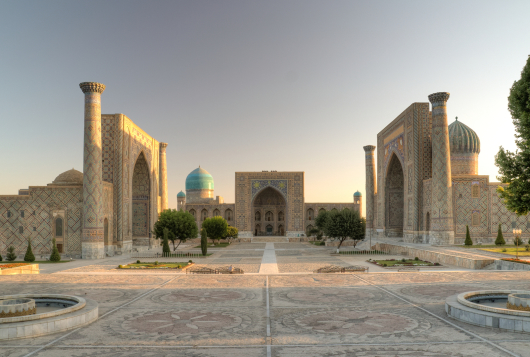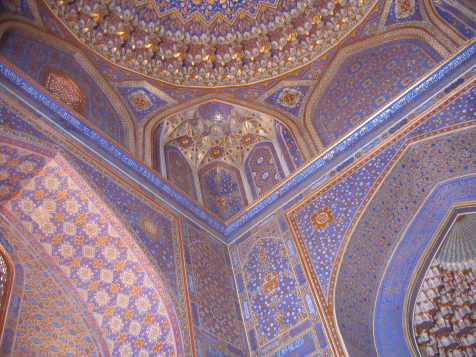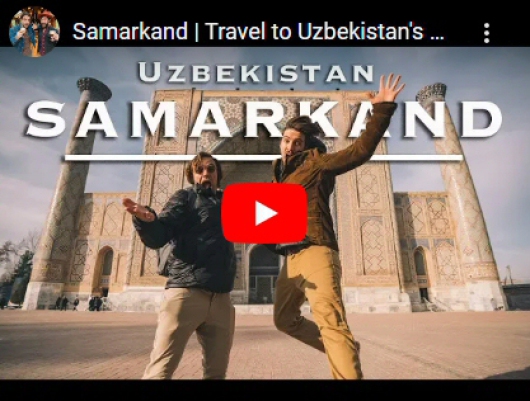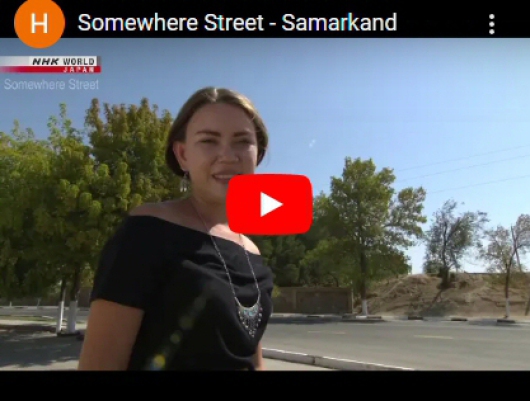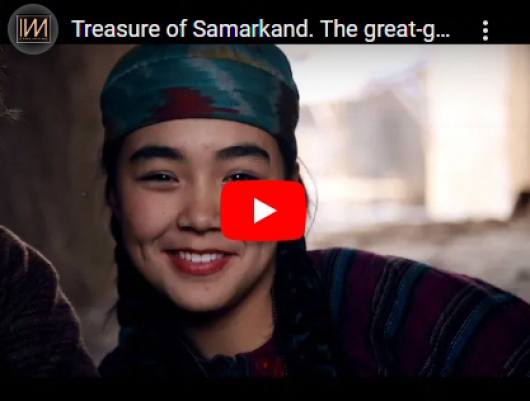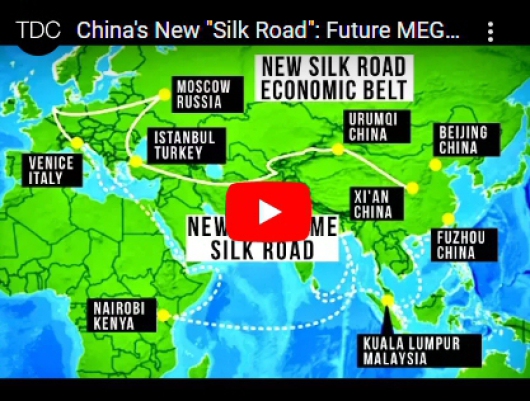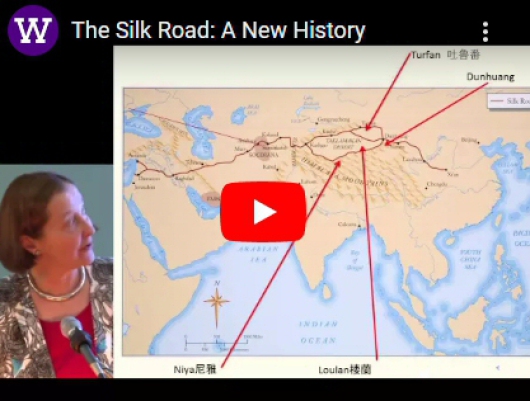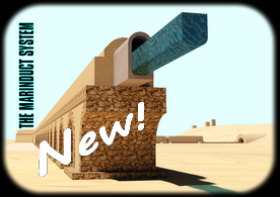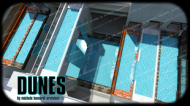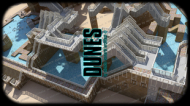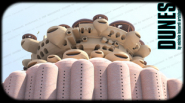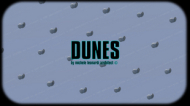Samarkand
8th century
Uzbekistan
Photograph of interior decorations of the Tilla Kari medersa
in Samarkand, taken by Gilad Rom. Source: Wikipedia .
Samarkand, Uzbekistan
Uzbekistan
Samarkand Bazaar
Samarkand:
Travel to Uzbekistan's Silk Road Treasure
Samarkand Street Food Tour
Somewhere Street, Samarkand
Uzbekistan during Bukhara Day
and Samarkand Registan
Treasure of Samarkand. The great-granddaughter
of the great Tamerlane. Reflections on history
Legendary Silk Road
Khiva
8th century
Uzbekistan
China’s "New" Silk Road
(...but now is already "Old")
The Silk Road: A "New" History
(...but now is already "Old")
Alireza Javaheri: "Suite Pasargad",
Santour Solo
BIBLIOGRAPHY
Bernard Ollivier: "Walking to Samarkand: The Great Silk Road from Persia to Central Asia", Skyhorse Publishing, 2020.
Acclaimed journalist Bernard Ollivier continues his epic journey across Persia and Central Asia as he walks the length of the Great Silk Road. Walking to Samarkand is journalist Bernard Ollivier's stunning account of the second leg of his 7,200-mile walk from Istanbul, Turkey, to Xi'an, China, along the Silk Road--the longest and perhaps most mythical trade route of all time. Picking up where Out of Istanbul left off, Ollivier heads out of the Middle East and into Central Asia, grappling not only with his own will to continue but with new, unforeseen dangers. After crossing the final mountain passes of Turkish Kurdistan, Ollivier sets foot in Iran, keen on locating vestiges of the silk trade as he passes through Persia's modern cities and traditional villages, including Tabriz, Tehran, Nishapur, and the holy city of Mashhad. Beyond urban areas lie deserts: first Iran's Great Salt Desert, then Turkmenistan's forbidding Karakum, whose relentless sun, snakes, and scorpions pose continuous challenges to Ollivier's goal of reaching Uzbekistan. Setting his own fears aside, he travels on, wonderstruck at every turn, borne by a childhood dream: to see for himself the golden domes and turquoise skies of Samarkand, one of Central Asia's most ancient cities. But what Ollivier enjoys most are the people along the way: Askar, the hospitable gardener; the pilgrims of Mashhad; and his knights in shining armor, Mehdi and Monir. For, despite setting out alone, he comes to find that walking itself-through a kind of alchemy-surrounds him with friends and fosters fellowship. From the authoritarian mullahs of revolutionary Iran to the warm welcome of everyday Iranians-custodians of age-old, cordial Persian culture; from the stark realities of former Soviet republics to the region's legendary bazaars-veritable feasts for the senses-readers discover, through the eyes of a veteran journalist, the rich history and contemporary culture of these amazing lands.
Yaffa Assouline: "Uzbekistan: The Road to Samarkand", Assouline Editor, 2020.
At the heart of Central Asia lies a land where colossal mountains and sweeping valleys sleep under a blanket of lush greenery. Crowned with golden palaces and wondrous monuments, the architectural landscape of the region is so rich with detail, the structures have been said to mirror the heavens themselves. One of the few destinations on Earth where imagination aligns with reality, Uzbekistan flourishes with unparalleled scenery and unforgotten traditions. The towns and cities are like "open museums", each edifice offering a unique and intricate aesthetic, each a testament to diverse cultural influences and diverse periods of history. Nature and architecture have a unique relationship, seemingly inspired by each other, as if they were trying to to outdo each other with their beauty. Discover the beautiful colors, textures and flavors of this incredible culture and journey through the cities of the Silk Road and the lands of Alexander The Great with stunning original photography by Laziz Hamani.
Henri Stierlin: "Islam: Early Architecture from Baghdad to Cordoba", Benedikt Taschen Verlag GmbH, Cologne, 1996.
This volume is an impressive survey of more than six hundred years of Islamic architecture, from the seventh to the thirteenth century, in a regio stretching frome the Near and the Middle East to Sicily, the Maghreb ans Andalusia. It presents masterpieces pf Islamic architecture from the peerless Dome of the Rock in Jerusalem to the mysterious Umayyad palaces in the deserts of Syria and Palestine, from the sumptuous residences of the caliphs in Samarra and Saragossa to the Great Mosques of Damascus, Kairouan and Cordoba.
Umberto Scerrato: "Islam", Art and Architecture, "Monuments of Civilisations", Littlehampton Book Services Ltd, Worthing, U.K., 1976.
Jim Al-Khalili: "The House of Wisdom: How Arabic Science Saved Ancient Knowledge and Gave Us the Renaissance", Penguin Books, 2012.
Many of the innovations that we think of as hallmarks of Western science had their roots in the Arab world of the middle ages, a period when much of Western Christendom lay in intellectual darkness. Jim al- Khalili, a leading British-Iraqi physicist, resurrects this lost chapter of history, and given current East-West tensions, his book could not be timelier. With transporting detail, al-Khalili places readers in the hothouses of the Arabic Enlightenment, shows how they led to Europe's cultural awakening, and poses the question: Why did the Islamic world enter its own dark age after such a dazzling flowering?
George Michell: "Architecture of the Islamic World: Its History and Social Meaning", Thames & Hudson, 1978.
Looks at the architecture of Islamic mosques, schools, gardens, caravanserais, bridges, markets, cities, homes, and fortresses, and discusses Islamic design and materials.
Michael Frishkopf and Federico Spinetti: "Music, Sound, and Architecture in Islam", 440 pages, University of Texas Press, TX, U.S.A., 2018.
Tracing the connections between music making and built space in both historical and contemporary times, Music, Sound, and Architecture in Islam brings together domains of intellectual reflection that have rarely been in dialogue to promote a greater understanding of the centrality of sound production in constructed environments in Muslim religious and cultural expression.
Representing the fields of ethnomusicology, anthropology, art history, architecture, history of architecture, religious studies, and Islamic studies, the volume's contributors consider sonic performances ranging from poetry recitation to art, folk, popular, and ritual musics—as well as religious expressions that are not usually labeled as "music" from an Islamic perspective—in relation to monumental, vernacular, ephemeral, and landscape architectures; interior design; decoration and furniture; urban planning; and geography. Underscoring the intimate relationship between traditional Muslim sonic performances, such as the recitation of the Qur'an or devotional songs, and conventional Muslim architectural spaces, from mosques and Sufi shrines to historic aristocratic villas, gardens, and gymnasiums, the book reveals Islam as an ideal site for investigating the relationship between sound and architecture, which in turn proves to be an innovative and significant angle from which to explore Muslim cultures.
Leyla Uluhanli: "Mosques: Splendors of Islam", Rizzoli, 2017.
Mosques from Europe, the Indian subcontinent, North America, North Africa and the sub-Sahara, the Middle East, and Russia and the Caucasus are showcased. This book covers their earliest origins in Mecca and Medina to contemporary masterpieces, illuminating their stylistic transformations and providing examples from Islam’s great dynasties—the Umayyads, the Abbasids, the Mamluks, the Ottomans, the Safavids, and the Mughals.
Eric Broug: "Islamic Geometric Design", Thames & Hudson, 2013.
Islamic geometric designs are admired worldwide for their beauty and marvelous intricacy, yet they are seldom understood. In this handsomely illustrated volume, Eric Broug analyzes and explains these complex designs in their historical and physical context.Broug shows how, over the centuries, craftsmen were able to adorn buildings with wonderful geometric patterns using the simplest of tools and without recourse to mathematical calculations. Design elements created from straight lines and circles were placed in grids and then repeated and varied to generate seemingly limitless arrays of breathtaking patterns.Chapters are devoted to each of the main families of geometric design—fourfold, fivefold, and sixfold—and to the complex combined patterns. Readers can follow the design processes by which these patterns were created and even learn to reproduce and invent geometric patterns for themselves. Broug’s original drawings accompany photographs of mosques, madrasas, palaces, and tombs from the Islamic world, ranging from North Africa to Iran and Uzbekistan, and from the eighth to the nineteenth centuries.
Moya Carey: "An Illustrated History of Islamic Architecture: An Introduction to the Architectural Wonders of Islam, from Mosques, Tombs, and Mausolea to Gateways, Palaces, and Citadels", Southwater Publisher, 2012.
A fascinating survey of the glorious architectural achievements of the Islamic world, including mosques, giblas, madrasas, memorials for the dead, bazaars, buildings, courtyards and fortified walls. Features all the most outstanding examples of Islamic architecture, such as the Dome of the Rock in Jerusalem, the Great Mosque in Damascus, the many richly decorated desert palaces, the Taj Mahal at Agra, Topkapi Palace at Istanbul, and today’s modern Dubai skyscrapers.
Diana Darke: "Stealing from the Saracens: How Islamic Architecture Shaped Europe", Hurst Publisher, 2020.
Against a backdrop of Islamophobia, Europeans are increasingly airbrushing from history their cultural debt to the Muslim world. But this legacy lives on in some of Europe's most recognizable buildings, from Notre-Dame Cathedral to the Houses of Parliament.
This beautifully illustrated book reveals the Arab and Islamic roots of Europe's architectural heritage. Diana Darke traces ideas and styles from vibrant Middle Eastern centers like Damascus, Baghdad and Cairo, via Muslim Spain, Venice and Sicily into Europe. She describes how medieval crusaders, pilgrims and merchants encountered Arab Muslim culture on their way to the Holy Land; and explores more recent artistic interaction between Ottoman and Western cultures, including Sir Christopher Wren's inspirations in the "Saracen" style of Gothic architecture.
Jonathan M. Bloom : "The Minaret", Edinburgh University Press, 2018.
Tracing its origins and development, Bloom reveals that the Minaret, long understood to have been invented in the early years of Islam as the place from which the muezzin gives the call to prayer, was actually invented some two centuries later to be a visible symbol of Islam.
Drawing on buildings, archaeological reports, medieval histories, geographies and early Arabic poetry, Bloom reinterprets the origin, development and meanings of the minaret. From early Islam to the modern world, and from Iran, Egypt, Turkey and India to West and East Africa, the Yemen and Southeast Asia, this richly illustrated book is a sweeping tour of the minaret's position as the symbol of Islam.
Hassan Fathy: "Natural Energy and Vernacular Architecture: Principles and Examples with Reference to Hot Arid Climates", The University of Chicago Press, Chicago, IL, U.S.A., 1986.
"The field of vernacular architecture offers an abundance of concepts that can be of use today in solving the critical housing situation now facing millions in the Third World. The example chosen to illustrate this by the UNU Energy Subprogramme covers the vernacular architecture of the hot, arid zones of the Arab World and neighboring regions. It was felt that the person best suited to prepare a monograph on this subject was Professor Hassan Fathy. Not only is Professor Fathy a master architect and an expert in the area of traditional architecture, especially in the Arab World, but he has been so for more than half a century. His work has also demonstrated the value that traditional architecture can have in improving the housing and living environments of the poor of the Third World. As a theoretician and practitioner of environmental planning design, Dr. Fathy's approach is based on a set of principles that are useful in opening the mind to the value of vernacular architecture and to adapting it to the situation in which a large fraction of the world's population find themselves today. Professor Fathy's approach is based on the concept that architectural form should be determined by spiritual, artistic, climatic, and social considerations as well as function, material, and structure. He emphasizes that due consideration must be given to a number of elements including harmony."
Ahmad Hamid: "Hassan Fathy and Continuity in Islamic Arts and Architecture: The Birth of a New Modern", The American University in Cairo Press, Cairo, Egypt, 2010.
Hassan Fathy, the Egyptian architect known for his recognition of the potential of vernacular forms as a vital force in contemporary architectural design, sought to integrate the traditions of Islamic art with his modern visions for living. Guided by Fathy's principles, Ahmad Hamid, an architect who collaborated with Hassan Fathy in the Institute for Appropriate Technology, identifies questions about the nature of Islamic art and its building culture, as well as the origins of modern architecture.
This richly illustrated book provides new insights into Hassan Fathy's profuse, pathbreaking design documents and built projects, while exploring the socioeconomic, environmental, psychological, and esthetic components of Fathy's work in the light of a quest for a new universal modernity for the twenty-first century.
Pietro Lureano: "Water Conservation Techniques in Traditional Human Settlements", Bollati Boringhieri, Turin, Italy, 2011; COPAL Publishing Group, New Dehli, India, 2013.
In this beautifully illustrated book, Author shares the fruits of more than a quarter of a century of careful observation of traditional knowledge and techniques applied to urban settlements and landscape resources management in all regions of the world. The book introduces us to very sophisticated, thousand-year-old, capacities developed by local communities and civilizations around the world, amongst which water harvesting techniques, recycling of organic wastes and used waters for soil fertility conservation or, in more general terms, the ecosystemic approach to town planning, are anything but new! Each traditional technique, classified and safeguarded, is an exceptional heritage of experience and knowledge which is in danger today but which may be spread and reused. However, it is not a question of reproducing exactly the solutions in each context but rather of adopting the logic within which they operate also by using advanced technologies. Natural cycles and traditional urban ecosystems show processes based on a harmonious use of resources wherein each manufacturing process produces wastes which are not a problem but are a source of materials for the other components of the overall activity. Traditional knowledge is, therefore, re-proposed as innovative, appropriate, and advanced knowledge for the elaboration of a new technological paradigm.
Michael Cook: "The Koran: A Very Short Introduction", Oxford University Press, U.K., 2000; Michael Cook: "Il Corano", in Italian, Einaudi Editore, Torino, 2001.
The Koran has constituted a remarkably resilient core of identity and continuity for a religious tradition that is now in its fifteenth century. In this Very Short Introduction, Michael Cook provides a lucid and direct account of the significance of the Koran both in the modern world and in that of traditional Islam. He gives vivid accounts of its role in Muslim civilization, illustrates the diversity of interpretations championed by traditional and modern commentators, discusses the processes by which the book took shape, and compares it to other scriptures and classics of the historic cultures of Eurasia.
Firas Alkhateeb: "Lost Islamic History: Reclaiming Muslim Civilisation from the Past", 248 pages, C. Hurst & Co., London, 2017.
Islam has been one of the most powerful religious, social and political forces in history. Over the last 1400 years, from origins in Arabia, a succession of Muslim polities and later empires expanded to control territories and peoples that ultimately stretched from southern France to East Africa and South East Asia.
Yet many of the contributions of Muslim thinkers, scientists and theologians, not to mention rulers, statesmen and soldiers, have been occluded. This book rescues from oblivion and neglect some of these personalities and institutions while offering the reader a new narrative of this lost Islamic history. The Umayyads, Abbasids, and Ottomans feature in the story, as do Muslim Spain, the savannah kingdoms of West Africa and the Mughal Empire, along with the later European colonization of Muslim lands and the development of modern nation-states in the Muslim world. Throughout, the impact of Islamic belief on scientific advancement, social structures, and cultural development is given due prominence, and the text is complemented by portraits of key personalities, inventions and little known historical nuggets. The history of Islam and of the world's Muslims brings together diverse peoples, geographies and states, all interwoven into one narrative that begins with Muhammad and continues to this day.
Amin Maalouf: "Samarkand", 320 pages, Abacus, London, 1994.
A Novel: Accused of mocking the inviolate codes of Islam, Persian poet Omar Khayyam fortuitously finds sympathy with the very man who is to judge his alledged crime. He is spared, and thus begins the blend of fact and fiction that is 'Samarkand'.
Fred M. Donner: "The Early Islamic Conquests", 510 pages, Princeton University Press, 2014.
In this contribution to the ongoing debate on the nature and causes of the Islamic conquests in Syria and Iraq during the sixth and seventh centuries, Fred Donner argues for a necessary distinction between the causes of the conquests, the causes of their success, and the causes of the subsequent Arab migrations to the Fertile Crescent. Originally published in 1982. The Princeton Legacy Library uses the latest print-on-demand technology to again make available previously out-of-print books from the distinguished backlist of Princeton University Press. These paperback editions preserve the original texts of these important books while presenting them in durable paperback editions. The goal of the Princeton Legacy Library is to vastly increase access to the rich scholarly heritage found in the thousands of books published by Princeton University Press since its founding in 1905.
John V. Tolan: "Saracens: Islam in the Medieval European Imagination", 400 pages, Columbia University Press, New York, NY USA-Chichester, West Sussex UK 2002.
In the first century of Islam, most of the former Christian Roman Empire, from Syria to Spain, was brought under Muslim control in a conquest of unprecedented proportions. Confronted by the world of Islam, countless medieval Christians experienced a profound ambivalence, awed by its opulence, they were also troubled by its rival claims to the spiritual inheritance of Abraham and Jesus and humiliated by its social subjugation of non-Muslim minorities. Some converted. Others took up arms. Still others, the subjects of John Tolan's study of anti-Muslim polemics in medieval Europe, undertook to attack Islam and its most vivid avatar, the saracen, with words.
In an effort to make sense of God's apparent abandonment of Christendom in favor of a dynamic and expanding Muslim civilization, European writers distorted the teachings of Islam and caricatured its believers in a variety of ways. What ideological purposes did these portrayals serve? And how, in turn, did Muslims view Christianity? Feelings of rivalry, contempt, and superiority existed on both sides, tinged or tempered at times with feelings of doubt, inferiority, curiosity, or admiration. Tolan shows how Christian responses to Islam changed from the seventh to thirteenth centuries, through fast-charging crusades and spirit-crushing defeats, crystallizing into polemical images later drawn upon by Western authors in the fourteenth to twentieth centuries. Saracens explores the social and ideological uses of contempt, explaining how the denigration of the other can be used to defend one's own intellectual construction of the world.
Irfan Shahid: "Rome and the Arabs: A Prolegomenon to the Study of Byzantium and the Arabs", 226 pages, Dumbarton Oaks, Washington, 1984.
Amin Maalouf: "The Crusades Through Arab Eyes", 293 pages, Abacus, London, (1983, the original French Edition; 1984, translated in English), 1989.
The author has combed the works of contemporary Arab chronicles of the Crusades, eyewitnesses and often participants. He retells their story and offers insights into the historical forces that shape Arab and Islamic consciousness today.
Kahlil Gibran: "The Prophet", 102 pages, Reader's Library Classics, 2021.
Through the voice of the prophet AlMustafa, Kahlil Gibran touches on the many intricacies of life and the human condition. Love, marriage, children, friendship, joy and sorrow — just a sample of the wide ranging thoughts that effortlessly touch on the mind and soul.
An inspiration to millions of people, The Prophet by Kahlil Gibran is widely considered to be a masterpiece of spiritual poetry. This book contains all twelve original drawings Gibran created specifically for The Prophet upon its first publication.
BIBLIOGRAFIA
Umberto Scerrato (archeologo, docente universitario; n. 1928): "Islam", Arte e Architettura, Collana "Le Grandi Civiltà", 192 pgg. formato in grande e illustrato, Arnoldo Mondadori Editore, Milano, 1972.
Jim Al-Khalili: "La casa della saggezza. L'epoca d'oro della scienza araba", 341 pgg., Bollati Boringhieri Editore, Torino, 2013.
Abu Rayhan al-Biruni, Ibn al-Shatir, al-Khwarizmi, Ibn al-Haytham, al-Razi. Dietro a questi nomi, per noi quasi sconosciuti, si nascondono in realtà le vite e le opere di scienziati che hanno posto le basi del mondo moderno. Jim Al-Khalili ricostruisce con straordinaria perizia la storia di un’epoca nella quale menti geniali spinsero le frontiere della conoscenza così in là da plasmare le civiltà che seguirono, fino ai giorni nostri. Il pensiero scientifico e culturale occidentale è in debito, ben più di quanto comunemente si pensi, con ciò che realizzarono mille anni fa gli scienziati e i pensatori del mondo islamico, in un periodo che fu elusivamente descritto come una lunga Età Oscura, una penosa parentesi posta tra la grande civiltà classica greco-latina e il Rinascimento europeo. Jim Al-Khalili, con la sua usuale prosa avvincente, ci svela i nomi dei protagonisti di questa avventura meravigliosa e troppo a lungo ignorata.
Violet Moller: "La mappa dei libri perduti. Come la conoscenza antica è stata perduta e ritrovata: una storia in sette città", 325 pgg., Mondadori, Milano, 2019.
Agli inizi del VI secolo, le popolazioni dell'Europa occidentale erano tormentate delle invasioni barbariche e i sovrani dell'impero romano d'Oriente attratti dall'opulenza e dal lusso: il patrimonio scientifico classico ed ellenistico sembrava in pericolo. Delle opere di Tolomeo, Euclide e Galeno erano sopravvissute solo poche copie, sparse tra Egitto, Siria, Anatolia e Grecia. Eppure, in un viaggio lungo un millennio, quei testi di astronomia, matematica e medicina, letti, tradotti e copiati nei centri di cultura medievali, riuscirono a sopravvivere e ad alimentare la rivoluzione scientifica moderna. È intorno a sette grandi città, crocevia di popoli, religioni e lingue attraverso i secoli, che ruota la ricostruzione della storica inglese Violet Moller alla ricerca delle tracce lasciate dagli intellettuali che hanno tramandato gli studi di questi celebri autori. Come Galeno di Pergamo, chiamato a Roma dall'imperatore per esercitare la professione di medico di corte dopo essersi formato a Smirne, Corinto e Alessandria d'Egitto, proprio dove Euclide compose gli Elementi e Tolomeo l'Almagesto. Quando la città sede della più ricca biblioteca dell'antichità andò in rovina, la sua eredità culturale trovò dimora nel mondo islamico: a Baghdad, grazie al mecenatismo del califfato, la ricerca matematica, amalgamando le conoscenze tradizionali alle rivoluzionarie scoperte indiane, lo zero e l'idea di infinito, raggiunse vette inaspettate. Giunta in Europa per fuggire alle persecuzioni degli Abbasidi, la dinastia omayyade portò l'eccellenza araba a Cordova, favorendo così il confronto tra studiosi ebrei, cristiani e musulmani e il perfezionamento di molte teorie scientifiche. Queste risalirono poi la penisola iberica fino a Toledo divenuta, con la Reconquista, la porta di accesso alla cristianità, che aveva preservato il sapere antico nei monasteri, tra i quali spiccava Montecassino. Toccò quindi all'Italia meridionale: a Salerno, Costantino l'Africano introdusse i testi di Galeno, che resero la scuola medica cittadina all'avanguardia nel campo della fisiologia e della farmacologia; a Palermo, maestosa capitale normanna, le opere furono tradotte direttamente dal greco al latino. Infine, il viaggio si conclude a Venezia, dove nella seconda metà del XV secolo le prime tipografie diedero alle stampe i manoscritti di quell'antica conoscenza, che, all'alba del Rinascimento, ha raggiunto le biblioteche disseminate in ogni angolo d'Europa per arrivare fino a noi. "La mappa dei libri perduti" è una storia delle idee e degli uomini che le hanno studiate, copiate, tradotte e diffuse, ma anche un invito a ritrovare i legami profondi tra il mondo islamico e quello cristiano, il cui incontro ha dato vita a un patrimonio intellettuale davvero universale.
Avicenna (Ibn Sīnā): "Metafisica", "La scienza delle cose divine" (al-Ilāhiyyāt), dal "Libro della Guarigione" (Kitāb al Šifā'), con testo arabo e latino; a cura di Olga Lizzini e Pasquale Porro; 1311 pgg., "Il Pensiero Occidentale", Bompiani-RCS Libri, Milano, 2006.
Nato nei pressi di Bukhara, nell'attuale Uzbekistan, Avicenna è il più importante pensatore dell'Islam orientale. L'impressionante vastità del suo sapere - fu a un tempo filosofo, consigliere politico e medico di grandissima fama - e il suo complesso lavoro di recupero e di ripensamento dell'eredità greca all'interno della fede islamica, giustificano l'indubbio fascino che la sua figura ha sempre esercitato tanto nel mondo arabo quanto in quello occidentale. La Metafisica, tradotta in latino nel XIII secolo, s'impose, accanto al corpus aristotelico, come il più autorevole punto di riferimento filosofico per i teologici scolastici, ed è a quest'opera che si devono di fatto alcune scelte epocali della filosofia occidentale.
Hermann Schreiber: "Gli Arabi in Spagna", 277 pgg., Garzanti, Torino, 1982.
Federico Donelli: "Islam e pluralismo. La coabitazione religiosa nell'Impero ottomano", 288 pagine, Mondadori Educational, Milano, 2017.
La Pax Ottomana ha rappresentato per oltre quattro secoli la cifra distintiva del più longevo degli imperi mediorientali: l'Impero ottomano. La formula che ha garantito la convivenza pacifica tra culture, lingue ed etnie all'interno di un territorio vastissimo come quello ottomano è oggi più che mai attuale, alla luce delle sfide proposte dall'elaborazione di progetti, analisi e politiche che vadano nella direzione di una mediazione tra Occidente e islam. Il volume, ripercorrendo la traiettoria storica ottomana, mostra come alla base della coabitazione vi fossero elementi riconducibili ad esperienze eterogenee, tra le quali il legalismo islamico, le consuetudini turco mongole, il misticismo sufi e la tradizione cristiano bizantina. Il millet, organizzazione comunitaria non territoriale, rappresentava l'approdo istituzionale della strategia di coabitazione ottomana e si rivelò essere la dimensione privilegiata in cui gli affiliati delle tre grandi comunità religiose (ebrei, cristiano-ortodossi e armeni) poterono contribuire attivamente alla vita di un Impero a maggioranza musulmana, diventandone un pilastro portante.
A cura di M. Hattstein M.: "Islam. Arte e architettura", 639 pgg., Konemann, 2001.
Dalla Spagna all'Irak, dalla Siria all'India passando per l'Asia centrale, arte e architettura dal passato al presente, con magnifico apparato iconografico quasi interamente a colori.
"Il Corano", con testo originale a fronte; a cura di Gabriele Mendel, traduzione e apparati critici (le note aggiuntive); con introduzione di Khaled Fouad Allam; 916 pagine in tutto; Istituto Geografico De Agostini, Novara, 2004; U.T.E.T., Torino, 2006-2016.
"Dormivo - scrive Maometto - quando Gabriele mi portò un panno di seta coperto di lettere e mi disse: 'Leggi'. Così io lo lessi e Gabriele mi lasciò. Mi svegliai ed era come se quelle parole mi si fossero impresse nel cuore". Nacque così, secondo la tradizione islamica, al-Qu'ran, il Corano, il Libro sacro, che non è altro che "copia" dell'originale celeste trascritto da Maometto. Parola di Dio trasmessa all'uomo e che l'uomo deve ripetere sempre uguale e immutabile nei secoli. E per evitare pericolosi errori, infatti, la liturgia prevede anche precise regole per la modulazione e la pronuncia della Parola, che non può e non deve cambiare. Introduzione di Khaled Fouad Allam.
Mohammad Ali Amir-Moezzi: "Dizionario del Corano", Edizione in italiano a cura Ida Zilio-Grandi, 1022 pagine in tutto; Mondadori, Milano, 2007.
Un dizionario con oltre 400 brevi saggi per conoscere il Libro Santo dei musulmani; le voci sono curate dai più importanti islamologi di Francia, Italia, Belgio, Tunisia, Algeria, Israele e Iran. L'islam e la civiltà islamica sono presentati in una prospettiva storica e geografica e nel rapporto con le altre religioni. Un'opera scientifica destinata al grande pubblico pensata con l'ambizione di essere anche e soprattutto "civica".
Ida Zilio-Grandi: "Il Corano", a cura di A. Ventura, traduzione di Ida Zilio-Grandi, Mondadori; LXXII pagine, con 900 pagine di commento; Milano, 2010.
Il Corano (in arabo "lettura") si è riproposto all'attenzione del mondo di oggi in tutta la sua straordinaria e spesso drammatica attualità. Letto e meditato in ogni continente del pianeta, questo libro rappresenta per più di un miliardo di fedeli dell'Islam la parola di Dio, il riferimento ideale dell'agire quotidiano, l'unico canone di comportamento etico e sociale. La sua conoscenza si impone a chiunque voglia cercare di capire i valori fondanti e gli odierni, evidenti disagi della seconda religione del mondo. Ma il Corano non è solo un codice di leggi, un'arida summa di obblighi e divieti, come vuole un'immagine tanto distorta quanto sin troppo diffusa. Il lettore potrà scoprire con sorpresa che il suo contenuto strettamente giuridico è modesto se confrontato con gli argomenti predominanti, che sono di natura teologico-religiosa. Il Corano è soprattutto un testo ispirato, un libro di rivelazioni nel quale prevalgono nettamente gli ammonimenti spirituali, le visioni apocalittiche, le storie dei profeti del passato, le prospettive dell'aldilà. Questa nuova traduzione, che ha l'obiettivo di presentare il Corano al grande pubblico con la maggior chiarezza possibile, rende la lingua araba originale in un italiano semplice e moderno, mentre il poderoso commento - fra i più ampi mai realizzati in una lingua occidentale e opera di un gruppo internazionale di specialisti - fornisce tutte le chiavi per penetrare nel ricco e complesso mondo dell'Islam.
Maurice Borrmans: "Gesù Cristo e i Musulmani del XX Secolo. Testi coranici, catechismi, commentari, scrittori e poeti musulmani di fronte a Gesù", 296 pgg., Edizioni San Paolo, Cinisello Balsamo, Milano, 2000.
Cosa pensano i musulmani d'oggi di Gesù? Cosa sanno i cristiani italiani della religione di moltissimi immigrati extracomunitari? Secondo l'autore di questo saggio, il dialogo deve crescere nella verità e nella conoscenza esatta di ciò che la religione musulmana crede e professa. In questo volume vengono presentati i versetti del Corano in cui si parla di Gesù, i principali catechismi musulmani contemporanei, i commentari coranici più importanti scritti in questo secolo e i trattati teologici. Non manca una parte riservata ai poeti e letterati musulmani e l'esame di alcune delle riviste ufficiali del pensiero religioso musulmano. La conclusione di fondo è che Gesù resta un mistero e un enigma e, su questo punto, si può aprire un fruttuoso dialogo interreligioso. Il volume è completo e aggiornatissimo, di grande interesse per studiosi, insegnanti di religione, associazioni che si occupano dell'integrazione degli extracomunitari. Maurice Borrmans, docente di Diritto Islamico, spiritualità musulmana e storia dei rapporti islamico-cristiani al Pontificio Istituto di Studi Arabi e Islamistica, ha compiuto i suoi studi universitari ad Algeri, ottenendo in seguito il dottorato di ricerca presso la Sorbona. Ha pubblicato numerosi saggi, fra i quali ricordiamo: Islam e Cristianesimo, Le vie del dialogo (San Paolo, 1993); dal 1985 è direttore della rivista Islamochristiana.
Alvise Andreose (a cura di): "La strada per il Catai. Contatti tra Oriente e Occidente al tempo di Marco Polo", Guerini e Associati, Milano, 2019.
A partire dagli anni Quaranta del Duecento, diversi viaggiatori approfittarono della situazione di stabilità politica che si era creata a seguito dell'unificazione di gran parte dell'Eurasia sotto i Mongoli, per intraprendere la via dell'Oriente, giungendo in Mongolia o spingendosi fino nel remoto Calai. Si aprì così una fase particolare nei rapporti tra il mondo asiatico e quello europeo. Da allora, per oltre un secolo mercanti - come il celebre Marco Polo (1254-1324) - e missionari - come il francescano Odorico da Pordenone (1280 ca.-1331) - si spostarono tra Ovest ed Est percorrendo la Via della seta o seguendo le rotte marittime che collegavano il Golfo Persico ai porti della Cina meridionale. Le informazioni trasmesse nei loro resoconti contribuirono a delineare una «nuova» immagine dell'Estremo Oriente, profondamente diversa da quella che il Medioevo aveva ereditato dall'Antichità. Il tema dei rapporti tra l'Occidente e la Cina nei secoli XIII-XIV - così importante per capire le modalità di rappresentazione dell'alterità nella cultura europea medievale - viene affrontato nel libro attraverso un approccio multiprospettico e trasversale, capace di far interagire e dialogare efficacemente saperi afferenti a discipline di diversa natura e tradizione. In particolare, l'eccezionalità dell'impresa di Marco Polo e la straordinaria ricchezza della sua opera costituiscono il nucleo ispiratore e la chiave di volta di molti dei saggi qui raccolti.
Liu Xinru: "La via della seta nella storia dell'umanità", 192 pgg., Guerini e Associati, Milano, 2016.
Per secoli, la Via della Seta ha rappresentato un ponte fra diverse civiltà, cruciale per gli scambi commerciali ma anche per la circolazione di idee. Oggi, con l'avanzare della globalizzazioni la sua suggestione rimane intatta. A rendere così affascinante la storia della Via della Seta contribuisce la duplice direzione in cui è stata percorsa, da Est verso Ovest e da Ovest verso Est, che spinge a superare la percezione di una irriducibile dicotomia Cina-Occidente, ancora troppo frequente nel sentire diffuso. Questo libro, dalla lettura scorrevole, fornisce un quadro semplice e sintetico ma al tempo stesso accurato di una storia complessa, lunga più di millecinquecento anni. Un ricco racconto insomma di viaggi, incontri e scontri, scambi di beni materiali, conoscenze tecniche, credenze religiose, lingue e arti. Oggi siamo tutti eredi di tante intelligenti interazioni tra popoli diversi, che questo volume segue in modo appassionante nel loro riecheggiare da un'area all'altra, da un secolo all'altro.
Vincenzo La Salandra: "Incursioni islamiche in Italia Centro-Settentrionale e Sardegna", 164 pgg., Ginevra Bentivoglio Editoria, 2017.
Il presente lavoro contiene una vasta collezione di stralci e spunti storiografici sul tema delle incursioni islamiche in Italia centro-settentrionale e in Sardegna, nell'alveo del più grande fenomeno dei contatti e degli scontri tra Paesi Europei e Impero Ottomano in epoca moderna. Il volume prosegue una precedente ricerca dedicata alle incursioni islamiche in Italia merdionale, estendendo le indagini fino alle soglie del XIX secolo. Completano il libro due appendici: una dedicata alle incursioni nel Mezzogiorno e una contenente alcune stampe settecentesche curate da Ferdinando Marsili. All'interno del volume vi è inoltre un corredo iconografico consistente in una serie di raffinate mappe realizzate nel XVI secolo dall'ammiraglio turco Piri Reis.
Franco Ciarleglio: "Mamma li turchi! Novelle, racconti e leggende medievali d’incursioni saracene nelle coste della Toscana e dell’Italia del Nord e del Sud", 56 pgg., Sarnus Editore, 2023.
Le incursioni dei pirati saraceni hanno interessato gran parte della penisola italiana, dalla Sicilia alla Liguria. I famigerati “turchi” – così venivano chiamati indistintamente i popoli arabi – erano protagonisti di spietate e sanguinarie scorrerie nelle città costiere, razzie che spesso hanno dato origine ad affascinanti leggende. Nelle storie qui raccolte, nate dall’eroica resistenza dei nostri antenati ma anche dalla ricchezza della fantasia popolare, non troveremo solo violenti agguati e schermaglie, ma anche amori e tradimenti, fantasmi e animali mitologici, e talvolta l’origine di feste, tradizioni e ricorrenze che sopravvivono ancora oggi.
Raffaele Speciale: "Locri Epizefiri. Dalle origine all'incursione saracena del 952", 226 pgg., FPE-Franco Pancallo Editore 2009.
Origini e vicende, costumi licenziosi e leggi severe, letteratura ed arte, paganesimo e cristianesimo in una delle città magnogreche più prestigiose offerti al lettore in una panoramica che interessa diciassette secoli di storia fino alla drammatica incursione dei saraceni di al-Hàsàn.
Salvatore Tramontana: “L'isola di Allah”, 432 pgg., Einaudi, Torino, 2014.
“Questo libro, nel quale all'islam è dato ampio spazio, non è una storia dei musulmani in Sicilia ma la storia dell'isola e di quel che in essa accadeva durante una delle tante dominazioni succedutesi nel tempo. Un tentativo, cioè, di individuare e porre a fuoco, per i secoli IX-XI, i luoghi, le "cose" e gli uomini di Sicilia ai quali dalla storiografia è stata spesso prestata scarsa attenzione probabilmente perché le fonti disponibili indugiano ampiamente su vicende militari e politiche e lasciano in ombra le condizioni materiali e sociali del vivere quotidiano.” Salvatore Tramontana, “L'isola di Allah”.
Giuseppe Bertolini: “Saraceni! Ianua 935 d. C.”, 449 pgg., Robin Editore, 2015.
Secolo X d.C., un secolo di ferro per un'Italia imbarbarita e devastata dalle guerre e da nuove invasioni: normanni, ungari e gli spietati seguaci di Maometto, i nuovi padroni del Mediterraneo, che con le loro navi portano morte e distruzione. Le vicende di Campo descritte in "Pollentia A.D. 402", ambientate nell'ultimo secolo di vita dell'Impero Romano, riprendono al tempo della lunga guerra longobardo-bizantina e proseguono tre secoli dopo, tornando a intrecciarsi con la storia, spesso oscura, dell'alto Medioevo. La Liguria di allora era soggetta a frequenti attacchi saraceni provenienti dal vicino covo di Frassineto, ma quello che accade in quel fatale 935 d.C. va ben oltre la semplice incursione, è una vera e propria spedizione di guerra che i fatimidi di Mahdia pianificano e portano prima alle coste della Sardegna e poi contro Genova, la città più importante e ricca dell'alto Tirreno. È in mezzo a questi fatti drammatici che vivono e si muovono i protagonisti del romanzo, in un ambito di dura a tragica realtà fatta di violenza, prevaricazione e morte, in cui solo l'amore riesce ad accendere un barlume di speranza, come accade tra Bianca e Americo e tra il maturo e disilluso Imberto e la bellissima e sfortunata Rebecca.
Amin Maalouf: "Le crociate viste dagli arabi", 488 pgg., La nave di Teseo, Milano, 2020.
Luglio 1096: fa molto caldo sotto le mura di Nicea. All’ombra dei fichi, nei giardini fioriti, circolano notizie inquietanti: una truppa formata da cavalieri, fanti, ma anche donne e bambini, marcia su Costantinopoli. Si dice che portino, cucite sulla spalla, delle croci in tessuto e che vengano a sterminare i musulmani fin dentro Gerusalemme. Resteranno due secoli in Terra Santa, saccheggiando e massacrando in nome del loro dio. Un’incursione barbara compiuta dall’Occidente contro il cuore del mondo musulmano segna l’inizio di un lungo periodo di decadenza e oscurantismo, e l’eco della violenza di quell’attacco si fa sentire ancora oggi. Nell’intento di raccontare le crociate da un punto di vista inedito e completo, Maalouf ha fatto ricorso agli scritti degli storici arabi, molti dei quali sconosciuti in Europa, gettando al di là della barricata uno sguardo che ci riserva non poche sorprese: un affresco a colori violenti, ma anche un monito inquietante per i nostri tempi. Torna in libreria, arricchito da una nuova introduzione dell’autore, il primo saggio scritto da Amin Maalouf, pubblicato nel 1983 e da allora divenuto riferimento critico essenziale per la comprensione del rapporto e delle tensioni più profonde fra il mondo arabo e quello occidentale.
Gibran Kahlil Gibran: "Il Profeta", con testo in inglese a fronte; 102 pagine, Guanda, 1986.
Recensione tratta da Wikipedia: Il profeta (The Prophet) è una raccolta di poesie di Khalil Gibran pubblicata nel 1923 a New York dall'editore Knopf. Si tratta di una raccolta di poesie in prosa legate da un filo comune narrativo, nel quale si inseriscono tematiche differenti. È strutturata a domande e risposte: per ogni argomento, un personaggio fa una domanda al Profeta, il quale risponde per metafore e analogie con un testo di tipo poetico. È un testo che ha molto di religioso, pur non inserendosi esattamente in nessuna religione, dato che parla di temi quali lo spirito, la mente, la natura.



